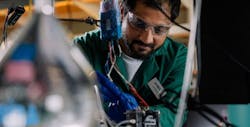University of Houston Highlights Carbon Capture Breakthrough Through Better Chemistry
Key Highlights
- The membraneless electrochemical process replaces costly membranes with gas diffusion electrodes, achieving over 90% CO₂ removal at approximately $70 per metric ton.
- This new method improves performance and reduces maintenance costs compared to traditional amine scrubbing techniques.
- The vanadium redox flow system captures CO₂ during charging and releases it during discharge, enabling simultaneous energy storage and carbon sequestration.
The energy engineering team at the University of Houston has detailed a pair of breakthroughs around carbon capture.
The team, led UH Cullen College of Engineering professor Mim Rahimi, introduced two potential pathways of decarbonization utilizing carbon capture through battery chemistry and electrochemical processes.
The first innovation, published in Nature Communications, has introduced a membraneless electrochemical process slashing energy requirement for amine-based carbon dioxide (CO₂) capture. The second one, featured on the cover of ES&T Engineering, demonstrated a vanadium redox flow system capable of both capturing carbon and storing renewable energy.
Originally published in a research paper titled “A Membraneless Electrochemically Mediated Amine Regeneration for Carbon Capture,” the team first focused on replacing the conventional ion-exchange membrane in the electrochemically mediated amine regeneration process with gas diffusion electrodes. The membranes were not only the most expensive part of the system but also a primary reason for performance issues and maintenance cost.
By engineering the gas diffusion electrodes, the team was able to achieve more than 90 percent CO₂ removal, nearly 50% more as compared to the traditional EMAR approaches. According to Ph.D. student Ahmad Hassan, this is a capture cost of approximately $70 per metric ton of CO₂, which makes it competitive with amine scrubbing methods.
Fellow University of Houston Ph.D. student Mohsen Afshari published his findings in “A Vanadium Redox Flow Process for Carbon Capture and Energy Storage.” The paper presented a reversible flow battery architecture absorbing CO₂ during charging and releasing it upon discharge. By leveraging the vanadium’s chemistry, the process displayed strong cycle stability and a high capture capacity, suggesting the technology will be able to provide carbon removal and grid balancing when paired with intermittent renewables.
“Integrating carbon capture directly into a redox flow battery lets us tackle two challenges in one device,” Afshari added. “Our front-cover feature highlights its potential to smooth out renewable generation while sequestering CO₂.”
